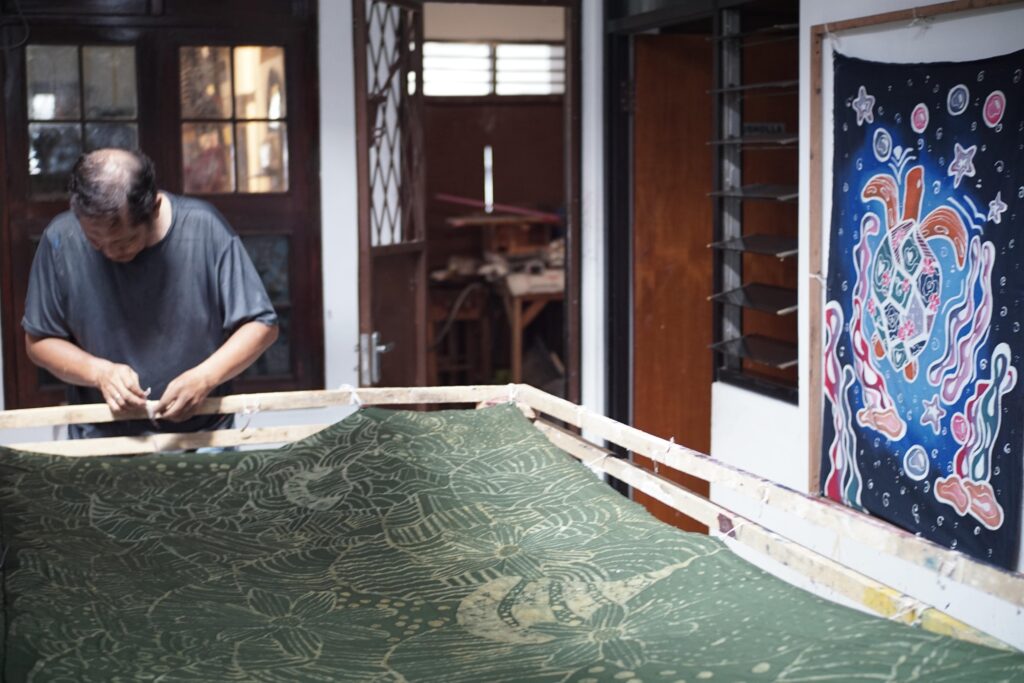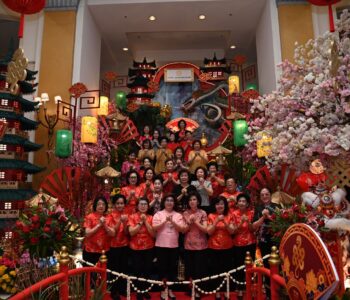
Unlike Solo, Pekalongan, Yogyakarta, Cirebon or Lasem, Jakarta is not on the radar when we think of batik producing regions. At least, it’s no longer on the radar, as Jakarta was once one of the main hubs for batik-making, complete with its own motifs and styles. So, what happened? Here we explore the history of batik in Jakarta and the organisations that are pushing for the industry’s revival in the city. / Photos by Begies Imanda.
Jakarta’s Batik-Making History
Jakarta and the Betawi people have their very own story about batik, the city was once bustling with batik producers in the 1900s until it declined significantly in the 1970s.
“At that time I was still a child, but I still clearly remember seeing the many batik makers in my village, Terogong. Palmerah, Rawa Belong, Patal Senayan and Tanah Abang were all centres of production too,” recounts Siti Laela, Founder of Batik Betawi Terogong. “Back then, in Kebayoran Lama, there even was a street named Jalan KPBD, an abbreviation of Koperasi Pengrajin Batik Djakarta (Djakarta Batik Craftsmen Cooperative). The majority of them bought fabrics from tauke (Chinese businessmen) in Jakarta or directly from China. And the Betawi batik motifs were mostly flora and fauna, and were influenced from Chinese’s taste. There were no ondel-ondel or Monas like today.”
The batik factories in Jakarta were mostly owned by those of Chinese descent who had lived in Jakarta for generations. This is explored in the book Batik Betawi Koleksi Hartono Sumarsono (2017), which tells the story of Lie Tian Tjeng, who arrived in Jakarta from China in 1906 to work in his relative’s batik factory in Karet. The area is not far from Tanah Abang market, found straddling the Krukut River — rivers were necessary for waste waster disposal.

At the end of the 20th century, Jakarta began to develop and urbanise. Bendungan Hilir, Karet, Palmerah, and Kebayoran Lama, which were all batik-making regions, transformed into business districts and/or elite residences, with development projects changing the economic landscape of the areas. In fact, the issuance of new regulations prohibited the existence of textile industries within Jakarta, due to how much factories were polluting the environment.
The batik makers thus moved to Tangerang, Cibitung, Cikarang, and East Karawang, leaving no batik makers in old town Betawi. Batik business in Jakarta declined and Jakarta turned into a centre for batik trade from regions outside Jakarta. With no producers from Jakarta, the Betawi batik motif also declined, drowned out by the popularity and abundance of batik from Pekalongan, Solo, Yogyakarta, and even from Semarang.
Preserving Batik in Jakarta: Kampung Batik Betawi Terogong and Rumah Batik Palbatu
On 2 October 2009, UNESCO officially designated batik as an Intangible Cultural Heritage of Humanity. It was recognised because it is made with techniques, has symbolism, and culture that is inseparable from the Indonesian culture and identity. This is why on 2 October Indonesia celebrates National Batik Day, commemorating this milestone global acknowledgement.
UNESCO’s recognition of batik became a spark of enthusiasm and hope for a handful of people looking to revive batik in Jakarta. These are not factories, of course, but home-scale batik artisanal centres, founded by those with a passion to preserve the culture of batik in Jakarta.

Siti Laela and her family members learned about batik Betawi through an initiative organised by DKI Jakarta Government through the Betawi Cultural Institute (LKB). After learning the techniques she then established Kampung Batik Betawi Terogong on 5 September 2012.
“Being Betawi myself, I want to revive the Betawi batik that once existed in my village. My mission at that time was not only to preserve Betawi batik but also use it as a means to safeguard my village, Terogong. As we know, this area is sandwiched between Pondok Indah and Fatmawati which is a business district that is always targeted by property developers. Part of the Terogong area has already been lost to development of the Pondok Indah area. My heart aches because this is my birthplace. To protect the village, it must have significance, so I made my house a cultural village that preserves Betawi batik and I thought that batik could be a solution for mothers here who do not have additional income for their families. So with limited capital, I revived the culture of batik in Terogong.” Laela asserted.
In the first three years, Laela struggled to motivate the women in her village. Not all of them were originally from Terogong, and lacked the same passion for batik. In 2014, Laela attended an exhibition and met psychologist Kassandra Putranto and actress Maudy Koesnaedi, both of whom were enamoured with the distinctive batik made by Laela. They were able to support by promoting the cause and empowering the women.



Through Terogong Betawi Batik, Laela wants to tell a story of Jakarta’s past, how it was once lush and that as a child she could climb the trees around her village. She incorporated some of the flora that grew in her beloved city, some of which is rarely seen these days, into the motifs, such as mengkudu (Indian mulberry), pihong (water henna), and jali-jali (Coix lacryma-jobi) trees. Visions of nostalgia, immortalised in cloth.
“But the market for such motifs got little response,” says Laela, a pragmatist wanted to find ways to make this product a success. “So now I make batik that incorporate more popular Jakarta imagery, such as ondel-ondel, Monas, tumpal, and even skyscrapers. At that time I produced hand-drawn batik, but now we also utilise stamp batik.”
Kampung Batik Betawi Terogong has now become a place for Jakarta residents to get authentic Betawi batik. In fact, Laela is often visited by guests and even foreign tourists from various backgrounds to learn batik. According to Laela, they are very interested in batik culture, so there is no reason for Indonesians not to be proud of their own cultural heritage.

Prior to Batik Betawi Terogong, there was Palbatu Batik Village, founded by Budi Dwi Haryanto and his friends back in 2011. The organisation was built on similar values, i.e. to help the local community, whilst also providing a hub for Jakarta residents to learn more about batik within the city. Palbatu, located between Tebet and Kuningan, has been known as a ‘silk road’ of sorts, both for business and as a tourist destination.
“After batik was designated as ‘world heritage’, how was it that Jakarta didn’t do anything for batik? We had the fabrics here, but no one to make it! Most of the batik in Jakarta is ‘printed’, that’s not truly batik. This was the motivation for my friends and I to dream up Palbatu as a cultural base for batik in Jakarta. It has great economic value through culture, attracting travellers fro around the globe,” shares Hari, as he is better known. Though originally from Ambarawa, Central Java, Hari fell in love with the Palbatu area and has been committed to its growth.
Collaborating with the community and some third parties, Hari transformed his neighbourhood into a batik village. The area became a canvas upon which batik visuals were painted upon, with 500 homes now adopting and promoting this unique visual identity.

On 21-22 May 2011, Hari and his friends on behalf of the Communication Forum for the Development of Palbatu Batik Village made an event by inviting 20 batik craftsmen from various regions in Java to come to Palbatu and give batik lessons with the aim of preserving batik culture with concrete actions. The creativity of the Palbatu community was rewarded with various awards, one of which was from the Indonesian Record Museum (MURI). The first record was the longest road with batik motifs (133.9 meters) and the second record was the most number of houses painted with batik motifs. Then in 2012, a big Jakarta Batik Carnival event was created.
“At that time, the enthusiasm of the community was very good. But as time went by, we made events but they had no impact, no one paid attention. Finally, I stopped hoping from the government. People only saw the potential but did not appreciate it. I was tired, I didn’t want to continue the name Kampung Batik Palbatu because I felt like it was false to say this… Finally, on 2 October 2013 I created Rumah Batik Palbatu,” shares Hari, recounting his disappointment at the time.
“I provide a home for those who are interested in batik, who love batik. It’s a batik laboratory and you could call it a community. The important thing is that this house will give birth to batik makers in Jakarta. It doesn’t mean we buy or sell batik from Java and have it recognised by Jakarta. That’s not the case.” Hari firmly stated.
Hari said that batik is the responsibility of Indonesian citizens, especially the state. The thing that concerns him the most is how to educate the Indonesian people, especially those in Jakarta, about the batik process. Batik is so often thought of as a ‘motif’, i.e. the finished product. In fact, what is recognised by UNESCO is the batik-making process. Hari believes that if more people valued the process, and therefore bought products authentically produced, then this would be a huge incentive for people to become batik makers.

“I hope the government and the people of Jakarta can get to know the batik process so that they can appreciate it by using real batik. Even if Jakarta no longer becomes the capital, it must have a strong cultural colour and character, one of which is batik which has gone global.” Hari added.
Through Rumah Batik Palbatu, Hari invites young people to be more aware about the batik process. He directs young people to create contemporary and more modern motifs. Although Hari is a big fan of classic batik, to attract young people to love batik, he introduces them to the motifs they love first. After that, they will naturally look for classic batik sources. Now, Rumah Batik Palbatu has been visited by many young people who want to learn about batik and even produce it.
“At the very least, young people can distinguish between authentic and imitation batik. The standard is written batik. If now many young people shop online and what they buy is mostly printed batik, what will happen? There will be no more batik makers in Indonesia.”
Kampung Batik Betawi Terogong
Jalan Terogong III No. 27C 9, RT 9 RW 10, Cilandak Barat, Jakarta Selatan 12430
+62 858-8316-3449
batikbetawiterogong.com
Rumah Batik Palbatu
Jalan Palbatu 1 No. 6, Menteng Dalam, Tebet, Jakarta Selatan 12870
+62 858-9128-8275, +62 856‑8154‑723
rumahbatikpalbatu.com






